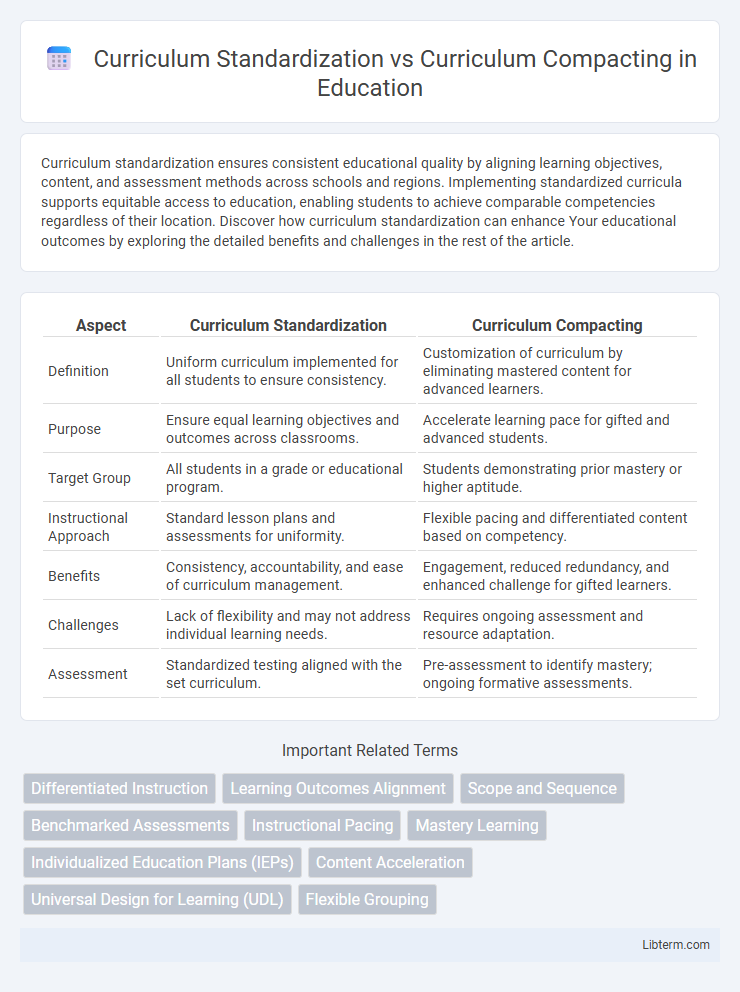Curriculum standardization ensures consistent educational quality by aligning learning objectives, content, and assessment methods across schools and regions. Implementing standardized curricula supports equitable access to education, enabling students to achieve comparable competencies regardless of their location. Discover how curriculum standardization can enhance Your educational outcomes by exploring the detailed benefits and challenges in the rest of the article.
Table of Comparison
| Aspect | Curriculum Standardization | Curriculum Compacting |
|---|---|---|
| Definition | Uniform curriculum implemented for all students to ensure consistency. | Customization of curriculum by eliminating mastered content for advanced learners. |
| Purpose | Ensure equal learning objectives and outcomes across classrooms. | Accelerate learning pace for gifted and advanced students. |
| Target Group | All students in a grade or educational program. | Students demonstrating prior mastery or higher aptitude. |
| Instructional Approach | Standard lesson plans and assessments for uniformity. | Flexible pacing and differentiated content based on competency. |
| Benefits | Consistency, accountability, and ease of curriculum management. | Engagement, reduced redundancy, and enhanced challenge for gifted learners. |
| Challenges | Lack of flexibility and may not address individual learning needs. | Requires ongoing assessment and resource adaptation. |
| Assessment | Standardized testing aligned with the set curriculum. | Pre-assessment to identify mastery; ongoing formative assessments. |
Understanding Curriculum Standardization
Curriculum standardization involves establishing uniform learning objectives, content, and assessment methods across educational settings to ensure consistent quality and equity in student outcomes. It emphasizes clear benchmarks aligned with national or regional education standards, facilitating comparability and accountability in teaching practices. Understanding curriculum standardization is crucial for developing structured frameworks that guide instructional design, assessment, and resource allocation.
What is Curriculum Compacting?
Curriculum compacting is an educational strategy that streamlines the standard curriculum by eliminating content that students have already mastered, allowing for more advanced or enriched learning opportunities. This approach tailors instruction to individual student needs, promoting efficient use of time and fostering deeper understanding in gifted or accelerated learners. Unlike curriculum standardization, which aims for uniform learning objectives, compacting emphasizes personalized pacing and differentiation within the existing framework.
Key Features of Standardized Curriculum
Standardized curriculum features include uniform learning objectives, consistent assessment methods, and structured content delivery to ensure equity across diverse classrooms. It emphasizes alignment with national or state standards, facilitating measurable student progress and accountability. Standardized curricula support scalability and comparability, enabling educators to systematically track educational outcomes.
Principles Behind Curriculum Compacting
Curriculum compacting is grounded in the principle of reducing redundancy by eliminating content mastery of already known material, thus allowing advanced learners to engage with enriched or accelerated instruction. It emphasizes personalized learning paths based on pre-assessment results to identify and waive mastered content, promoting efficiency in curriculum delivery. This approach contrasts with curriculum standardization, which aims to maintain uniform content coverage for all students regardless of prior knowledge or skill level.
Benefits of Standardized Curriculum
Standardized curriculum ensures consistent learning outcomes by aligning educational content with national or state standards, promoting equity across diverse classrooms. It facilitates streamlined assessment and benchmarking, enabling educators to track student progress effectively and identify areas needing intervention. This uniformity supports efficient resource allocation and teacher training, enhancing overall instructional quality and student achievement.
Advantages of Curriculum Compacting
Curriculum compacting offers significant advantages by allowing advanced students to bypass redundant instruction and engage in more challenging and enriching content tailored to their abilities. This approach increases student motivation and time efficiency, enabling learners to master key concepts quickly while fostering critical thinking and creativity. Schools implementing curriculum compacting report improved academic outcomes and higher student satisfaction compared to standardized curricula.
Challenges of Curriculum Standardization
Curriculum standardization faces challenges such as limiting teacher autonomy and stifling creativity, resulting in a one-size-fits-all approach that may not meet diverse student needs. It can lead to rigid pacing, which hampers differentiation and fails to accommodate varied learning speeds or styles. Additionally, standardized curricula often struggle to integrate local or cultural relevance, reducing student engagement and real-world applicability.
Limitations of Curriculum Compacting
Curriculum compacting, designed to streamline content for advanced students, faces limitations such as potentially overlooking foundational knowledge critical for holistic understanding and creating gaps in learning progression. The absence of standardized guidelines can lead to inconsistent application, resulting in varied educational outcomes and challenges in assessing student competency uniformly. Additionally, compacting may reduce opportunities for skill reinforcement and mastery, impacting long-term retention and readiness for subsequent academic challenges.
Comparing Curriculum Standardization and Compacting
Curriculum Standardization establishes a uniform set of learning objectives and content for all students, ensuring consistency in educational outcomes across diverse classrooms, while Curriculum Compacting focuses on tailoring instruction by identifying and eliminating already mastered material to accelerate learning for advanced students. Standardization supports equity by providing a common framework, whereas compacting emphasizes personalized pacing and depth, allowing gifted learners to engage in enriched or advanced topics. Both approaches impact curriculum design but differ fundamentally in their goals: broad uniformity versus individualized acceleration.
Choosing the Right Curriculum Approach
Choosing the right curriculum approach depends on aligning educational goals with student needs, where curriculum standardization ensures uniform learning outcomes and compliance with set benchmarks, promoting consistency across classrooms. Curriculum compacting, on the other hand, targets high-achieving or accelerated learners by streamlining content to eliminate redundancies, allowing for enrichment and deeper exploration in key subject areas. Effective curriculum planning requires balancing standardization for equity with compacting strategies that foster individualized advancement, supported by data on student performance and instructional capacity.
Curriculum Standardization Infographic

 libterm.com
libterm.com